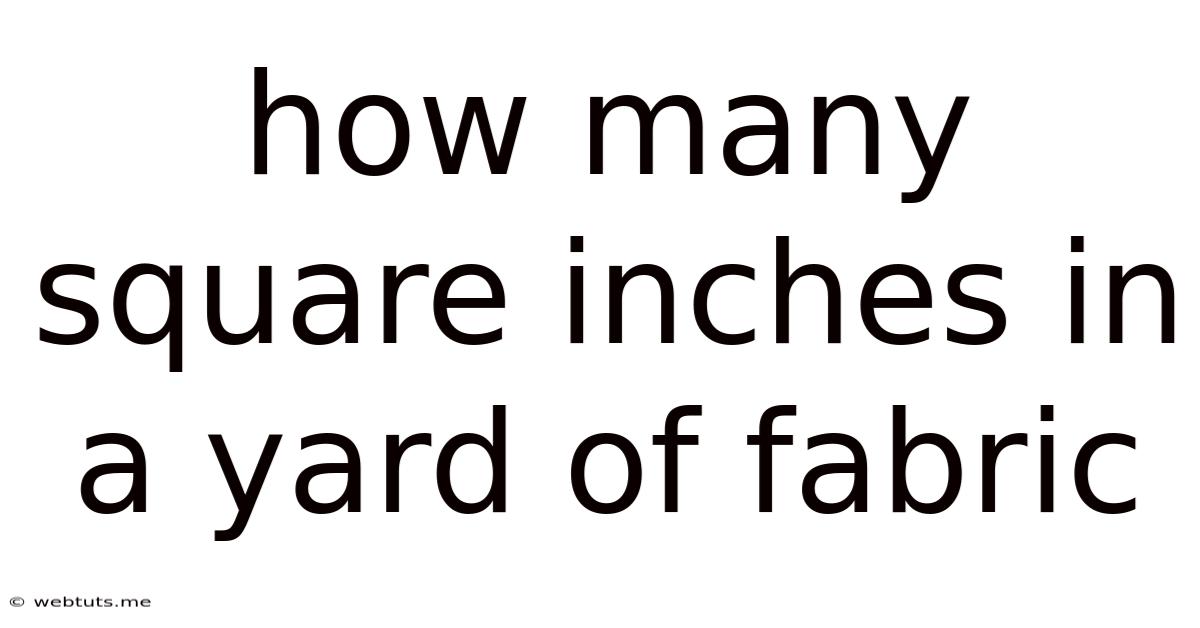How Many Square Inches In A Yard Of Fabric
Webtuts
May 14, 2025 · 5 min read

Table of Contents
How Many Square Inches in a Yard of Fabric? A Comprehensive Guide
Knowing how many square inches are in a yard of fabric is crucial for various sewing and crafting projects. Accurate calculations ensure you purchase the correct amount of material, minimizing waste and saving you money. This comprehensive guide will not only answer the question but also delve into the intricacies of fabric measurement, provide helpful conversion tips, and offer practical applications to enhance your crafting experience.
Understanding Fabric Measurements: Yards, Inches, and Square Inches
Before diving into the calculation, it's important to grasp the fundamental units of fabric measurement. Fabric is typically sold by the yard, a linear measurement equal to 3 feet or 36 inches. However, when calculating fabric requirements for a project, you're actually dealing with square inches or square yards, representing the area the fabric covers.
The Importance of Square Inches
While you buy fabric by the yard (linear measurement), your project's needs are determined by the fabric's area. Square inches provide a precise measurement of this area, essential for patterns that require specific fabric amounts. Understanding square inches is pivotal in accurately estimating fabric needs, ensuring you have enough material and avoid costly mistakes.
Calculating Square Inches in a Yard of Fabric
A yard of fabric is 36 inches long. To determine the square inches, we need to consider the width of the fabric. Fabric width varies depending on the type of material. Common widths include 45 inches, 54 inches, and 60 inches. Let's break down the calculation for each:
45-inch wide fabric:
- Length: 36 inches (1 yard)
- Width: 45 inches
- Square Inches: 36 inches * 45 inches = 1620 square inches
Therefore, one yard of 45-inch wide fabric contains 1620 square inches.
54-inch wide fabric:
- Length: 36 inches (1 yard)
- Width: 54 inches
- Square Inches: 36 inches * 54 inches = 1944 square inches
One yard of 54-inch wide fabric contains 1944 square inches.
60-inch wide fabric:
- Length: 36 inches (1 yard)
- Width: 60 inches
- Square Inches: 36 inches * 60 inches = 2160 square inches
One yard of 60-inch wide fabric contains 2160 square inches.
Practical Applications and Project Planning
Knowing the square inches in a yard of fabric isn't just about numbers; it's about effective project planning. Here’s how this knowledge translates into practical application:
1. Accurate Pattern Estimation:
Many sewing patterns specify fabric requirements in square inches or square yards. By knowing the width of your chosen fabric, you can easily calculate whether one yard will suffice or if you need more. This avoids frustrating mid-project fabric shortages. Always account for extra fabric for seams, adjustments, and potential mistakes.
2. Minimizing Fabric Waste:
Precise calculations reduce fabric waste. When cutting multiple pieces from a yard of fabric, understanding the available square inches helps you plan the layout efficiently, minimizing scraps. Techniques like nesting patterns and utilizing remnant pieces can significantly reduce waste.
3. Cost Savings:
Accurate fabric estimations lead to cost savings. Buying only the necessary fabric prevents unnecessary expenses. Careful planning, especially for larger projects, can result in considerable savings over time.
4. Quicker Project Completion:
Properly estimating fabric needs streamlines the project. You'll spend less time shopping for additional fabric and more time focusing on the creative process, leading to quicker project completion.
Beyond the Basics: Additional Considerations
While the calculations above provide a foundation, several factors influence fabric needs:
1. Fabric Shrinkage:
Certain fabrics, like cotton and linen, can shrink after washing. Always pre-wash fabric before cutting and sewing to account for shrinkage, preventing potential size issues in your finished project. This pre-washing step might require additional fabric.
2. Pattern Complexity:
The complexity of a pattern affects fabric needs. Patterns with intricate details or multiple layers generally require more fabric than simpler designs.
3. Fabric Design and Matching:
Fabric designs, particularly those with large patterns or directional prints (like stripes or florals), need careful planning to match elements throughout the project. This might require purchasing extra fabric to ensure proper alignment and avoid mismatches.
4. Seam Allowances:
Always add seam allowances to your pattern pieces. Seam allowances are extra fabric added to the edges for stitching and creating neat seams. These allowances contribute to the overall fabric requirements.
5. Additional Considerations for Specific Projects:
Different projects have unique fabric needs. For instance, quilting projects might require extra fabric for piecing and border additions, while garment construction might necessitate additional fabric for ease of movement and fitting adjustments.
Conversion Tools and Resources
While manual calculations are valuable for understanding the process, online conversion tools can streamline the process. Many websites offer fabric calculators that automate the calculations, considering fabric width and pattern needs. These tools can be particularly useful for complex projects with multiple fabric components.
Conclusion: Mastering Fabric Measurement for Success
Understanding the relationship between yards, inches, and square inches is fundamental for success in sewing, quilting, and other fabric crafts. Accurate calculations based on fabric width ensure you purchase the right amount of fabric, minimizing waste, saving money, and streamlining your projects. Mastering these calculations empowers you to confidently tackle any fabric project, knowing you have the correct materials and reducing potential frustrations along the way. Remember to always consider factors like fabric shrinkage, pattern complexity, and design alignment when estimating your fabric requirements. With careful planning and precise measurements, your crafting journey will be smoother and more rewarding.
Latest Posts
Related Post
Thank you for visiting our website which covers about How Many Square Inches In A Yard Of Fabric . We hope the information provided has been useful to you. Feel free to contact us if you have any questions or need further assistance. See you next time and don't miss to bookmark.